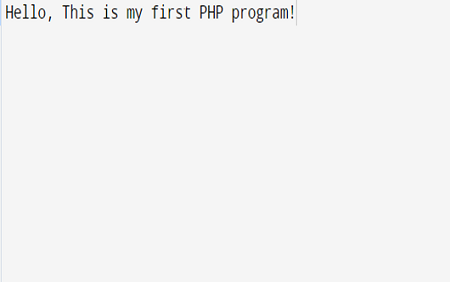Home »
PHP
PHP Introduction
By Shahnail Khan Last updated : November 25, 2023
PHP, or Hypertext Preprocessor, is a widely used backend language that made it possible for millions of websites to operate seamlessly. It's known for its versatility and ease of use, making it a popular choice for web development.
What is PHP?
PHP is a server-side scripting language that enables dynamic and interactive web pages. It is embedded in HTML code and executed on the web server before being sent to the user's browser.
PHP can handle various tasks. It serves the following purposes -
- Generating dynamic web pages
- Connecting to and manipulating databases
- Processing user input
- Creating and managing cookies and sessions
- Sending and receiving emails
Why Use PHP?
PHP offers several advantages for web development. Let’s have a look at the key features.
- Open-source and free-to-use
- Easy to learn and use, especially for those who know HTML very well
- Widely supported by web hosting providers
- Large and active community of developers
- Versatility for handling various web development tasks
Applications of PHP
Below are the applications of PHP programming:
- Web Development
- Content Management Systems (CMS)
- E-Commerce Websites Development
- Social Media Platforms Development
- Enterprise Applications Development
- Web Services Development
- Intranet Applications Development
- Online Forums and Bulletin Boards Development
- Server-Side Data Processing and Analysis
- Educational Platforms Development
- Blogging Platforms Development
- Real-Time Chat Applications Development
- Image and File Processing
- CRM (Customer Relationship Management) Development
- Utilities and Scripts Development
Getting Started with PHP
To get started with PHP, you'll need a web server with PHP installed. Most web hosting providers offer PHP hosting, making it easy to set up your development environment.
PHP code is enclosed in <?php and ?> tags (PHP Syntax). Variables are prefixed with a dollar sign ($) and data types are not explicitly declared. Let's have look at the simple PHP program.
Example
This a simple PHP program where "Hello, this is my first PHP program" is displayed on the browser.
<?php
echo "Hello, this is my first PHP program!";
?>
Output:

Explanation:
- <?php is the starting tag to write PHP code.
- echo is a PHP statement that displays the output data to the screen. The echo statement can be used with or without parathesis.
- >? is the closing tag.
Essential PHP Concepts
To effectively use PHP, you should understand these core concepts -
- Variables: Store data and can be manipulated using various operators.
- Data Types: Represent different types of data, such as integers, strings, and Booleans.
- Operators: Perform operations on data, including arithmetic, comparison, and logical operators.
- Control Flow Statements: Control the execution of code based on conditions (if statements) or repetitions (loops).
- Functions: Reusable blocks of code that perform specific tasks.
- Arrays: Collections of data elements that can be accessed using indexes.
Advertisement
Advertisement